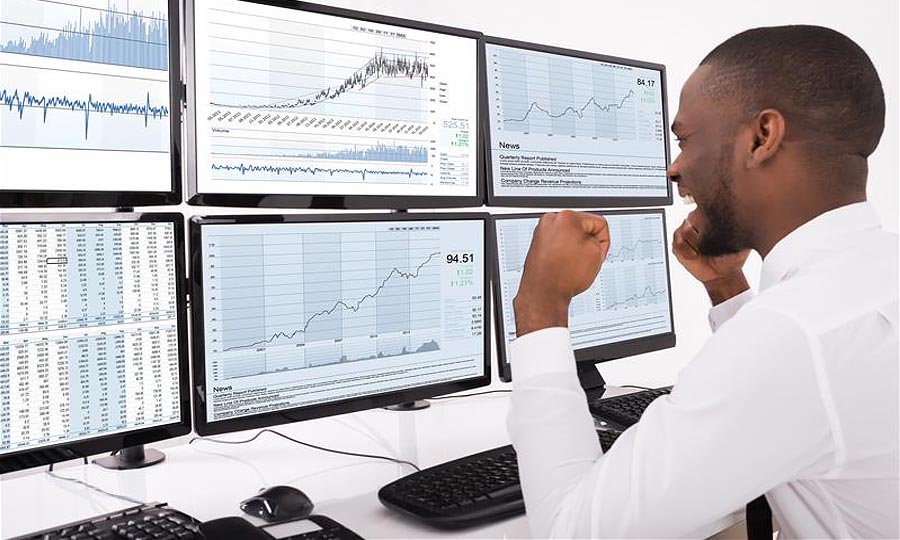
8 minute read
How To Start FOREX Day Trading for beginners
Day trading in forex (foreign exchange) involves buying and selling currency pairs within the same trading day. Unlike long-term trading where positions are held for days, weeks, or months, day trading aims to take advantage of short-term market fluctuations. If you’re a beginner looking to start day trading in forex, this guide will provide you with the necessary steps, strategies, and tips to get started.
Best Forex broker in the world
1️⃣ Exness: Open Account | Go to Website
2️⃣ JustMarkets: Open Account | Go to Website
3️⃣ XM: Open Account | Go to Website
4️⃣Pepperstone: Go to Website
5️⃣Avatrade: Open Account | Go to Website
6️⃣FpMarkets: Open Account | Go to Website
7️⃣XTB: Go to Website
8️⃣FBS: Go to Website
9️⃣Amarkets: Go to Website
Step 1: Understand the Basics of Forex Day Trading
Before diving into day trading, it’s essential to have a solid understanding of the forex market.
Key Concepts You Need to Know:
Currency Pairs: Forex trading always involves two currencies. The first currency is the base currency, and the second is the quote currency. Popular currency pairs include EUR/USD, GBP/USD, and USD/JPY.
Pips and Lots: A pip is the smallest price movement in a currency pair, typically measured to the fourth decimal place. A lot refers to the size of a trade—standard lots are usually 100,000 units of the base currency.
Leverage: Leverage allows traders to control a larger position with a smaller amount of capital. While leverage can amplify profits, it also increases the potential for losses.
Spreads and Commissions: The spread is the difference between the buy and sell price of a currency pair, and brokers may charge a commission for each trade.

Step 2: Choose the Right Forex Broker for Day Trading
To engage in forex day trading, you need to choose a reliable forex broker. Since day trading relies on quick decision-making and precise execution, selecting a broker with a suitable trading platform is crucial.
What to Look for in a Forex Broker:
Regulation: Ensure the broker is regulated by reputable authorities, such as the Financial Conduct Authority (FCA) or the U.S. Commodity Futures Trading Commission (CFTC).
Trading Platform: A good broker will offer platforms like MetaTrader 4 (MT4) or MetaTrader 5 (MT5), which are known for their advanced charting tools, custom indicators, and automated trading capabilities.
Low Spreads: Since day traders rely on small price movements, brokers offering low spreads are often more suitable for this trading style.
Fast Execution: Speed is essential in day trading, so choose a broker with a reputation for fast execution and minimal slippage (the difference between expected and actual trade prices).
Step 3: Practice with a Demo Account
Before risking your money, it’s essential to practice day trading with a demo account. A demo account mimics live trading conditions but uses virtual money, which allows you to hone your skills without financial risk.
Why a Demo Account is Important:
Familiarize Yourself with the Platform: Get comfortable using the broker’s trading platform and learn how to place orders, set stop-loss levels, and use technical tools.
Test Your Strategies: Use the demo account to test various day trading strategies and determine what works best for your trading style.
Build Confidence: Practicing on a demo account will give you the confidence to start trading with real money once you’re comfortable.
Step 4: Develop a Day Trading Strategy
A trading strategy is a set of rules that guide your entry and exit points. As a day trader, you’ll need a strategy that suits the fast-paced nature of the market.
Common Day Trading Strategies:
Scalping: This involves making small, frequent trades throughout the day to capture small price movements. Scalping requires a high level of focus, speed, and discipline.
Trend Following: Traders using this strategy look for currency pairs that are trending strongly in one direction and aim to trade in the direction of the trend.
Range Trading: Range traders buy at support levels and sell at resistance levels, typically in a flat or sideways market. This strategy is ideal when the market is not trending strongly.
Key Elements of a Day Trading Strategy:
Entry Points: Identify when to enter a trade based on technical indicators, chart patterns, or market news.
Exit Points: Set profit targets (take-profit) and stop-loss levels to minimize potential losses and lock in profits.
Risk Management: Always risk a small percentage of your account balance on each trade (typically 1-2%). This will help you avoid significant losses and protect your capital.
Step 5: Understand Technical Analysis for Day Trading
Since day trading relies on short-term market movements, technical analysis is crucial for making informed decisions.
Tools for Technical Analysis:
Candlestick Patterns: Candlestick charts are used to analyze price movements. Common patterns include Doji, Engulfing, and Hammer, which can help predict market reversals or continuations.
Indicators: Use indicators like Moving Averages, RSI (Relative Strength Index), and MACD (Moving Average Convergence Divergence) to spot trends, overbought/oversold conditions, and potential entry points.
Support and Resistance Levels: Identify key support and resistance levels on the chart. These levels indicate where the price has historically reversed or paused, and they are essential for setting stop-loss and take-profit levels.
Step 6: Set Up a Risk Management Plan
Risk management is crucial in day trading because of the fast-paced nature of the market. Without a proper risk management plan, it’s easy to make emotional decisions that lead to large losses.
Effective Risk Management Strategies:
Stop-Loss Orders: Always set a stop-loss order to limit your potential losses. For example, if the market moves against you by a certain amount (e.g., 20 pips), the stop-loss order will automatically close the trade.
Risk-to-Reward Ratio: Aim for a risk-to-reward ratio of 1:2 or higher. For every dollar you risk, try to make at least two dollars in profit.
Position Sizing: Only risk a small percentage of your account on each trade. A good rule is to risk no more than 1-2% of your account balance per trade.
Step 7: Start Trading with Real Money
Once you’ve practiced with a demo account and feel confident in your strategy, it’s time to start trading with real money. However, always start small to minimize the risks associated with live trading.
Tips for Beginner Day Traders:
Start Small: Begin with a small account balance and trade with micro or mini lots. This allows you to gain experience without risking too much capital.
Stay Disciplined: Stick to your trading plan and avoid chasing the market. Emotional trading can lead to impulsive decisions that result in losses.
Keep a Trading Journal: Track your trades, strategies, and outcomes. A journal helps you identify patterns in your trading and learn from both your successes and mistakes.

Step 8: Stay Updated with Market News
Forex markets are highly sensitive to global economic and political events. As a day trader, staying updated with the latest news is vital to understanding market movements and making informed decisions.
Useful Sources of Market News:
Economic Calendars: These provide information on scheduled economic events like central bank meetings, GDP reports, and unemployment data, which can significantly affect currency prices.
Financial News Websites: Websites like Bloomberg, Reuters, and CNBC offer up-to-date news on economic events and market analysis.
Social Media and Forums: Engage with other traders on platforms like Twitter and Reddit for real-time market discussions and news.
Step 9: Keep Learning and Improving
Day trading is a continuous learning process. As you gain more experience, refine your strategies and adapt to the ever-changing forex market.
Ways to Improve as a Day Trader:
Learn from Mistakes: Review your trading journal and analyze what worked and what didn’t. Avoid repeating mistakes.
Follow Expert Traders: Many successful traders share their insights through blogs, podcasts, and webinars. Follow them to stay updated with new strategies and tips.
Educate Yourself: Read books, take online courses, and participate in trading webinars to deepen your understanding of forex day trading.
Conclusion
Forex day trading offers exciting opportunities, but it requires dedication, discipline, and a solid strategy. By following this step-by-step guide and continuously improving your skills, you can become a successful day trader. Remember to practice with a demo account first, start small, and always manage your risks. With patience and perseverance, you can navigate the fast-paced world of forex day trading and achieve long-term success.
Best Forex broker in the world
1️⃣ Exness: Open Account | Go to Website
2️⃣ JustMarkets: Open Account | Go to Website
3️⃣ XM: Open Account | Go to Website
4️⃣Pepperstone: Go to Website
5️⃣Avatrade: Open Account | Go to Website
6️⃣FpMarkets: Open Account | Go to Website
7️⃣XTB: Go to Website
8️⃣FBS: Go to Website
9️⃣Amarkets: Go to Website
See more:
How To Start FOREX Trading in Nigeria for beginners
How To Start FOREX Trading in South Africa for beginners
How To Start FOREX Trading in Dubai for beginners
How To Start FOREX Trading in Pakistan for beginners










